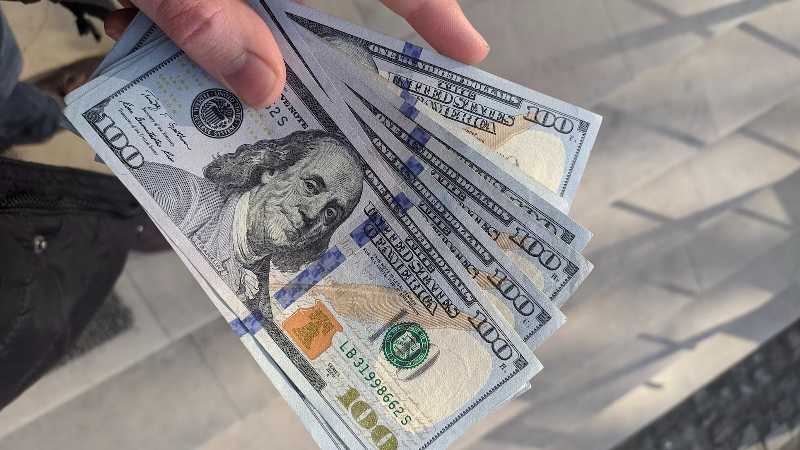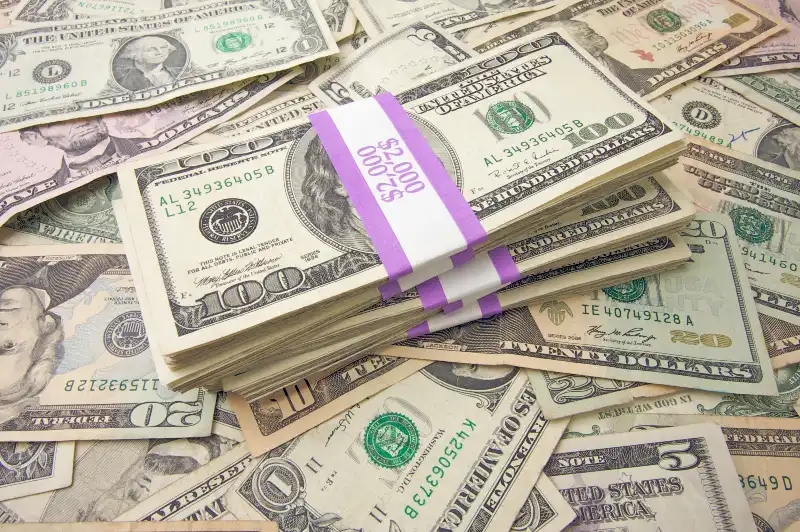Have you ever wondered how people in movies and TV shows refer to large sums of money using terms like stacks, racks, and bands?
These words pop up in flashy scenes describing wealth and luxurious lifestyles, often leaving viewers intrigued about what they really mean.
Whether it be lyrics in a hit song or dialogue from your favorite crime thriller, understanding these slang terms can add an extra layer of realism to the entertainment you consume.
Let’s see these money slang, and clear up any confusion about stacks, racks, and bands.
1. Stacks
When characters in films speak about ‘stacks’ of money, they’re referring to an image many of us dream about: piles of cash neatly arranged, signifying wealth and success.
However, the term ‘stack’ isn’t just Hollywood flair; it has a place in real-world financial terms.
What Is a Stack of Money?

A stack of money is commonly understood to mean a neat pile of currency, usually bound together. The visual is straightforward: think of a deck of playing cards, but replace the cards with banknotes.
In financial slang, a stack can also signify a specific amount of money, though this meaning can vary based on context and region.
How Much Is a Stack of Money?
The actual value of a stack can vary widely, but in many cases within the United States, a stack is typically referred to as $1,000. This figure may have evolved from the standard practice of bundling cash into groups of 100 banknotes.
Since the most commonly circulated bill is the $10, this would naturally amount to $1,000 per stack. However, the denomination of the bills can change the total value of the stack, so it’s always best to clarify the worth when dealing with financial negotiations.
The Origins of “Stack of Money”
The term ‘stack’ dates back centuries, with the earliest uses related to orderly piles of items such as plates or coins. Over time, ‘stack’ became a part of colloquial language referring to money.
In many urban music genres such as hip-hop and rap, the term has been popularized to boast about wealth, reflecting the cultural significance and aspirations of financial success. The depiction of stacks of money in media has further solidified the term in modern day term.
2. Racks
Now that we’ve got a grasp on stacks, let’s stack up our knowledge with insights into ‘racks.’
What Is a Rack of Money?

A rack of money, another popular term used to describe a large sum of cash, often appears in contexts similar to stacks. Visually, a rack suggests a more extensive, orderly array of money than a stack.
While stack implies a single pile, a rack may invoke the concept of money being shelved or stored in larger quantities that are systematically organized – almost like a rack of merchandise.
How Much Is a Rack of Money?
Determining the amount of money in a rack can be less standardized than a stack. Primarily in the context of American slang, a rack is usually synonymous with $1,000, much like a stack.
This term can also be used more loosely in casual conversation, sometimes referring to any large amount of money regardless of the precise figure.
The Origins “Rack of Money”
The term ‘rack’ has less clear historical origins when it comes to money. It’s a relatively new addition to the lexicon of financial slang, with its popularity surging in the late 20th and early 21st centuries, again through its use in hip-hop and rap music.
Much like with stacks, racks entered the mainstream due to cultural influences and are now more commonly used to depict significant sums of money.
3. Bands
Unlike the previous two terms, bands do not directly refer to an amount of money but rather to a physical aspect of how money is often stored or organized.
What Is a Band of Money?

In the term of money, a band is quite literally a band—a strip of paper, rubber, or other material used to wrap around and hold together a bundle of banknotes.
When someone refers to a band of money, they usually mean a stack of cash secured by one of these bands.
Although the term may not quantify a specific amount, it conveys an image of money that’s both substantial and ready for transactional use.
How Much Is a Band of Money?
The actual value contained within a band can vary. It depends entirely on the denomination of the bills and how many are included in the bundle.
In many cases, a band holds together a standard bundle of 100 bills. Similar to a stack, if the bills are $10 bills, a band would then typically encompass $1,000, but if they were $100 bills, that same band would secure $10,000.
Often, bands come into play in banking or large cash businesses, where money needs to be neatly organized and counted. Due to the variability in how much a band can represent, it’s usually defined by the context in which it’s used.
The Origins of “Band of Money”
The use of bands to keep money organized is practical and likely as old as paper currency itself. The term ‘band’ may not carry the same cultural weight or historical depth as ‘stack’ or ‘rack’, but it emerged from the straightforward necessity of grouping and managing large amounts of cash.
In popular culture, ‘band’ has become more prevalent with the increased display of wealth and the glamorization of the counting and handling of large sums of money. The phrase is often heard in songs, especially in genres that emphasize wealth and luxury.
Certain bands, like those provided by banks, may even come with color-coding or markings indicating the total value they secure, further cementing their association with substantial sums of money.
Common Misconceptions about Stacks, Racks, and Bands
While stacks, racks, and bands are handy slang terms used to discuss money, especially in the realm of entertainment, they can lead to confusion without a proper understanding of their meanings. Here are some common misconceptions about these terms.
Misconception 1: They Always Represent the Same Amount of Money
One major misconception is that the terms ‘stack’, ‘rack’, and ‘band’ always refer to the same, specific amount of money.
As we’ve seen, while a stack or a rack often correlates to $1,000, it can vary with the denomination of bills used. A band doesn’t even specify a monetary amount but rather how the money is held together, and the value can vary widely based on the bills wrapped within.
Misconception 2: They Are Formal Financial Terms
Another common misconception is that these terms are formal financial language. In actuality, stacks, racks, and bands are informal slang terms that have gained popularity through culture, especially from music and movies.
While you might use them in everyday conversation, they’re not typically used in professional financial settings or official banking documents.
Misconception 3: They Are Interchangeable
They are not interchangeable. A stack is a set of money typically worth a certain amount, usually thought of as $1,000. A rack, though often equated to the same value, carries its own connotations and might be used in slightly different contexts or even to represent larger sums.
A band, on the other hand, is a physical object used to secure money and doesn’t dictate value by itself. Understanding the distinction is important to accurately interpret discussions of money, particularly in situations where precision is crucial.
Misconception 4: They Are Modern Inventions
While the use of these terms in popular music and media may be relatively recent, the concepts behind stacks, racks, and bands are not modern inventions.
The act of stacking or bundling money dates back to when paper currency became widespread.
Bands have been used for as long as there has been a need to keep large amounts of cash organized. Their emergence in slang undoubtedly gave these terms a current twist, but their origins are far older.
Misconception 5: They Indicate Illegally Earned Money
Films and songs often depict stacks, racks, and bands in the context of illicit activities, leading some to associate these terms exclusively with illegal earnings.
In reality, these words simply relate to the form or amount of currency and make no inherent statement about the legality of the funds.
Legal, cash-intensive businesses like restaurants, bars, or retail stores might just as well refer to the ‘bands’ used to organize their legitimate daily takings.
Likewise, someone saving cash for a significant purchase or keeping an emergency fund might talk about their savings in terms of ‘stacks’ without any nefarious implications.
Conclusion
Now you may know what it means when someone mentions stacks, racks, or bands. This insight will not only allow you to approach the topic of money with more confidence but also make it easier to understand the financial terms you often encounter in daily life.





